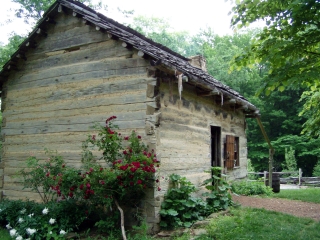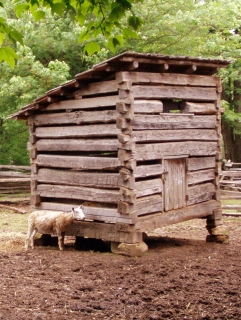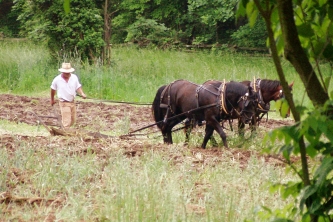NPS Website; Local Website
 WHAT IS IT?
WHAT IS IT?Part of the grounds of the 160-acre farm where Abraham Lincoln lived from the ages of seven to 21.
BEAUTY (4/10)
The rolling green hills of Indiana surround the site and provide a warm rural setting. The one-story semi-circular Indiana limestone Visitor Center is tastefully understated. The limestone is adorned with carved murals representing periods of Lincoln’s life. Abraham life and growth as a man is also honored on a lovely half-mile walk through the woods entitled ‘The Trail of Twelve Stones’. The Trail stops humbly contain twelve representative stones. Three of which are a stone from the Gettysburg National Cemetery, a stone from the White House and a stone from his wife’s childhood home.
HISTORICAL INTEREST (7/10)
The Site emphasizes that Abraham Lincoln became a man here at the farm. His life was a struggle. His family had recently been evicted from their home in Kentucky because of an invalid deed. Two years after their move to Indiana, a nine-year old Abraham buried his mother who died from milk sickness. Years later he would bury his older sister, who died along with her newborn, during childbirth.
Every instance one learns about Abraham’s boyhood explains much of his motivation and reasoning later in life. Of course he chose law, learning and literacy; his father had been fleeced of his life’s earnings a few times in Kentucky because of his illiteracy and ignorance of the law. Of course Abraham fought against slavery, his parents had chosen Indiana so that they could be in a slavery-free state. We could go on for paragraphs.
The Site also has a working living history farm. There is a cornfield that is plowed 19th Century style by cattle. There are live chickens and goats. There is a smokehouse, a typical log cabin and a smith shop. Period-dressed Rangers demonstrate typical pioneer life in an attempt to show how the Lincolns lived. They succeed.
 CROWDS (8/10)
CROWDS (8/10)There were a lot of kids at the Site. The Rangers were able to capture their exuberance and channel it into a positive learning experience. We were excited. Everyone seemed to be excited.
EASE OF USE/ACCESS (4/5)
Like the Lincoln Birthplace NHS, brown signs are plentiful. We didn’t have any difficulty finding the site. The parking lot was ample, the Visitors Center one-story and accessible. It is a ½ mile walk on the Lincoln Boyhood Trail to the neatest part of the site, the Lincoln Historical Farm, or one may choose to drive to a closer parking lot and walk a short distance from there. The Trail of Twelve Stones is flat and well-maintained, but not paved. Paths at the Lincoln Historical Farm are uneven and rocky.
CONCESSIONS/BOOKSTORE (2/5)
A surprisingly poor selection of Lincoln books. The bookstore consisted of two or three shelves lining the Visitor Center hallway next to the information desk.
COSTS (3/5)
The Site is $2 per adult, $4 per family, free with National Parks Pass. The Living Historical Farm is open from May-Sept. At these prices, the Site is a remarkable bargain.
RANGER/GUIDE TO TOURIST RATIO (5/5)
There were four Rangers at the Visitor Center and four Rangers dressed in period costume at the Living Historical Farm. We arrived at the Site during the very busy spring Field Trip season. In the two hours we spent at the Site, the Rangers had three groups of middle schoolers, 300 kids, on their watch. All of the Rangers still made a concerted effort to talk to us and answer our barrage of questions. They even squeezed us into seats 88 and 89 of the 90-seat theater instead of making us wait until the kids were done. We felt welcomed, honored and informed.
TOURS/CLASSES (8/10)
Not only were the Rangers good to us, they were great with the students. We sat in on a half-hour long six-grade presentation of Abe’s boyhood life. The Ranger enlisted the kids to represent each member of Abe’s Indiana circle. We saw these students marry, move in with the Lincolns, die, give birth and move to Springfield, Illinois. Initially the lecture was cute and nostalgic. Who doesn’t remember the pre-teen revulsion and embarrassment of having to marry someone you definitely do not like in front of your peers. As the Ranger continued, we realized that we were learning a lot about Abe and the dynamics of his early life; a lot more than either the museum panels or the video had taught us.
The Living Historical Museum and the Trail of Twelve Stones are done superbly. They allow you to learn at your own pace through imagination, visual reference and question and answer sessions.
FUN (8/10)
Everyone we met was really friendly. When the one female Ranger ushered us into her cabin and told us to make ourselves at home, we didn’t know if she was in character or just being herself. When one of the Rangers plowing the field struck up a conversation with us like he had known us for ages, we had the same question. It was only after he expressed dread at the full docket of school groups that we realized his hospitality had nothing to do with his costume.
 WOULD WE RECOMMEND? (8/10)
WOULD WE RECOMMEND? (8/10)We’re not sure how you would build this stop into a family vacation unless you are already planning a journey across southwest Indiana. It is an uneventful hour and a half drive from Louisville, KY. The closest attraction to the Boyhood NMEM is Holiday World/Splash and Safari in Santa Claus, Indiana. We know nothing about that other than the barrage of radio commercials we heard.
Even though the site is a little out of the way, it has a lot to offer at a very reasonable price. We spent over two hours at the site. It might have been more had rain clouds looked less ominous. The Rangers were some of the best we have seen – friendly, full of knowledge and ready to share. One really does come away with a better understanding of the events and atmosphere which shaped Abraham Lincoln.
TOTAL 57/80
www.usa-c2c.com
© 2004-06